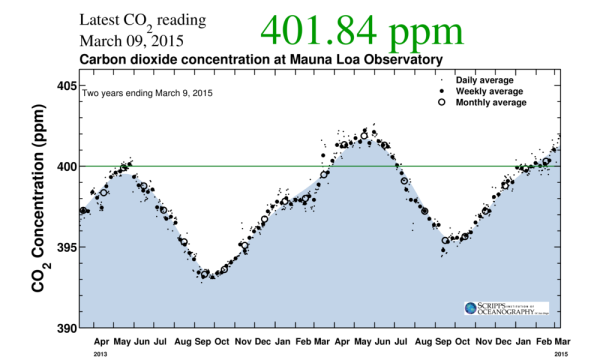Entering
the Middle Miocene — CO2 Likely to Hit 404 Parts Per Million by May
11
March, 2014
The
Pliocene. A
period of time 2-5 million years ago hosting carbon dioxide levels
ranging from 350 to 405 parts per million and global average
temperatures that were 2-3 degrees Celsius hotter than 1880s
levels. The great ice sheets of
Greenland and West Antarctica were feeble, if they existed at all.
And seas were about 25-80 feet higher than today.
(CO2 hit above 401.84 parts per million on March 9, 2015, and above 403 parts per million on March 10 — levels that test the upper boundary of CO2 last seen during the Pliocene and entering a range more similar to the Miocene. Image source: The Keeling Curve.)
In
the context of human warming, the amount of heat forcing we’ve
added to the global atmosphere from carbon dioxide emissions alone
has been hovering in the range of the Pliocene for the past two
decades. A heat forcing that, if it remained steady over a
substantial period of time, would almost certainly revert the world
to a climate state last seen during that time.
But
by 2015, the global human heat forcing from carbon dioxide emissions
had begun to exit the period of the Pliocene. Now we are entering a
period in which atmospheres are more similar to those seen during the
Middle Miocene Climate Optimum — the last time CO2 measures
exceeded a threshold of roughly 405 parts per million
(see here and here)
The
Middle Miocene Climate Optimum occurred between about 15 and 17
million years ago.
It hosted an atmosphere in which carbon dioxide levels varied wildly
from 300 parts per million to 500 parts per million. Temperatures
were between 3 to 5 degrees Celsius hotter than the 19th Century. And
sea levels were about 120 to 190 feet higher.
During this period, the world was still cooling down from the heat of
the Paleocene and Eocene epocs. Carbon was being sequestered. And it
was the first time the world broke significantly below a 500
part per million CO2 plateau that had been established during the
Oligocene 24 to 33 million years ago.
The
great glaciers in East Antarctica were mostly well established, even
though their scope was a mere shadow of what we see today. The
Greenland and West Antarctic glaciers did not exist. They would have
to wait for about another 5-10 million years for the Earth to cool
further.
(Glaciation since PETM. Image source: Dr James Hansen.)
As
of March 9, 2015, atmospheric CO2 levels had reached 401.84 parts per
million. Already a level testing the
Pliocene-Miocene boundary, this measure will continue to increase
through the rest of March, on into April, and keep rising until
middle or late May. At that point, global CO2 levels will have
reached around 404 parts per million. At least the highest levels
seen in the last 3 million years and possibly the highest levels seen
in 15 to 18 million years.
If
the greater portion of this range is correct, then
we are now breathing air that none among our species or even our
hominid relatives have ever breathed since their setting foot on this
world.
But
CO2 alone doesn’t tell the whole story. Equivalent CO2 levels
(CO2e) including all human emitted greenhouse gasses — methane and
a host of industrial gasses — will reach about 484 ppm CO2e this
year (see here and here).
And that forcing puts us easily within the range of the warmest
periods of the Miocene. A brew of heat trapping gasses including
exotic chemicals that no creature has likely ever breathed while
living on the Earth.
Links:
Hat
tip to Aldous





No comments:
Post a Comment
Note: only a member of this blog may post a comment.